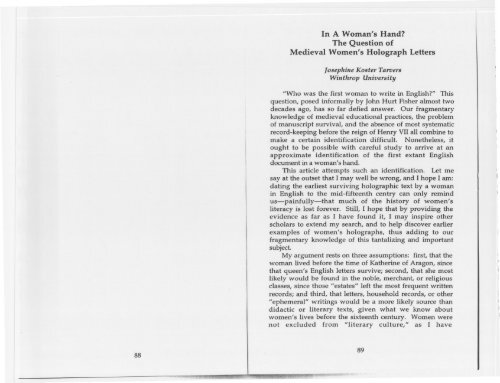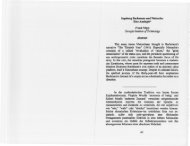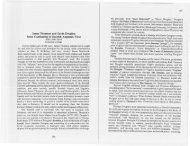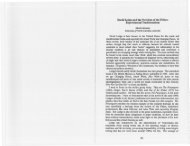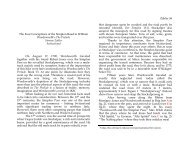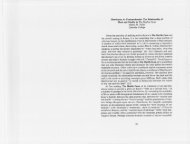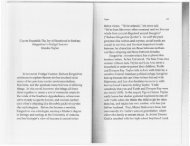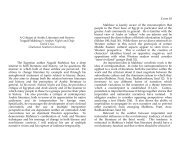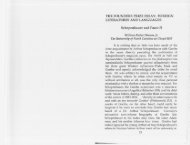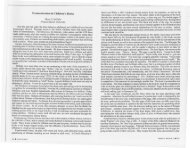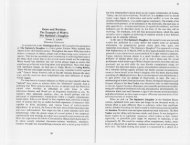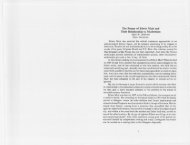In A Woman's Hand? The Question of Medieval Women's Holograph ...
In A Woman's Hand? The Question of Medieval Women's Holograph ...
In A Woman's Hand? The Question of Medieval Women's Holograph ...
You also want an ePaper? Increase the reach of your titles
YUMPU automatically turns print PDFs into web optimized ePapers that Google loves.
<strong>In</strong> A <strong>Woman's</strong> <strong>Hand</strong>?<strong>The</strong> <strong>Question</strong> <strong>of</strong><strong>Medieval</strong> <strong>Women's</strong> <strong>Holograph</strong> LettersJosephine Koster TarversWinthrop University"Who was the first woman to write in English?" Thisquestion, posed informally by John Hurt Fisher almost twodecades ago, has so far defied answer. Our fragmentaryknowledge <strong>of</strong> medieval educational practices, the problem<strong>of</strong> manuscript survival, and the absence <strong>of</strong> most systematicrecord-keeping before the reign <strong>of</strong> Henry VII all combine tomake a certain identification difficult. Nonetheless, itought to be possible with careful study to arrive at anapproximate identificationdocument in a woman's hand.<strong>of</strong> the first extant EnglishThis article attempts such an identification. Let me. say at the outset that I may well be wrong, and I hope I am:dating the earliest surviving holographic text by a womanin English to the mid-fifteenth centry can only remindus-painfully-that much <strong>of</strong> the history <strong>of</strong> women'sliteracy is lost forever. Still, I hope that by providing theevidence as far as I have found it, I may inspire otherscholars to extend my search, and to help discover earlierexamples <strong>of</strong> women's holographs, thus adding to ourfragmentary knowledge <strong>of</strong> this tantalizing and importantsubject.My argument rests on three assumptions: first, that thewoman lived before the time <strong>of</strong> Katherine <strong>of</strong> Aragon, sincethat queen's English letters survive; second, that she mostlikely would be found in the noble, merchant, or religiousclasses, since those "estates" left the most frequent writtenrecords; and third, that letters, household records, or other"ephemeral" writings would be a more likely source thandidactic or literary texts, given what we know aboutwomen's lives before the sixteenth century. Women werenot excluded from "literary culture," as I have8889..; rvwL-W~--~
.. ... ... ,.'01. ,.. .'... d... '.'._~demonstrated elsewhere. However, their spheres <strong>of</strong> powerand literacy were more likely to be domestic. Europeanmedieval law made books and other writing implementspart <strong>of</strong> a woman's household property as her inheritancerights-just as it did her kitchen utensils (Bell 155).Women were taught the abc's before the age <strong>of</strong> five, so thatthey could read their Psalter, and, equally as importantly,keep the household accounts. So domestic writings seemmoreotherlikely to yield examplesareas.<strong>of</strong> women's hands than doAs we well know, many obstacles faced the womanwriter: exclusion from clerkly education as a consequence <strong>of</strong>exclusion from religious orders; the high cost <strong>of</strong> writingmaterials, which caused so many texts to be written onmargins, dorses, scraps, and recycled skins; the tradition <strong>of</strong>employing male clerks and secretaries, particularly in therising middle classes; and the considerable risk <strong>of</strong>accusations <strong>of</strong> heresy for being literate in the vernacular.No holograph manuscript <strong>of</strong> an English woman's literarycomposition apparently has survived. But letters-theseare another story.English letters from women <strong>of</strong> nobility survive from asearly as the 1500s. We are accustomed, <strong>of</strong> course, tothinking <strong>of</strong> Elizabeth I at the end <strong>of</strong> the sixteenth centuryas literate-and indeed she was. Examples <strong>of</strong> her Italichandwriting survive, such as those in BL MS Lansdowne1236 as a twenty-three-year-old supplicant to her cousinMary Tudor in 1553, and in BL MS Addit 18738 as a seventyyear-oldmonarch writing to her heir, James I, in 1603 (Gregplate XCI, a-c). <strong>In</strong> the latter, she makes the famousreference to "my skrating hand" in describing herhand writing. As one can see by comparing the twomanuscripts, it was age, rather than lack <strong>of</strong> skill, whichcaused the degeneration in her handwriting; certainly shewas not, as one unidentified historian averred, "nearlyincapable <strong>of</strong> forming her letters" (Tudor Royal Letters 16).<strong>The</strong> Italian humanists had introduced the Italic handto England, and it was this hand that Elizabeth, like herhalf-sister Mary and Mary's mother Katharine beforethem, learned to write. <strong>The</strong> high-minded reason for such astyle was that it was the style <strong>of</strong> the Humanists, clear andelegant as the texts that it recorded. But in point <strong>of</strong> fact, asMartin Billingsley noted in <strong>The</strong> Petts Excellettcie (1618),there were other reasons men taught women to write theItalic rather than the secretary hand:it is conceiued to be the easiest hand that is writtenwith Pen, and to be taught in the shortest time:<strong>The</strong>refore it is vsually taught to women, for as much asthey (hauing not the patience to take any great paines,besides phantasticall and humoursome) must be taughtthat which they may instantly learne. (Dawson 10)But their "phantasticall" and "humoursome" natures aside,women's letters written earlier than the sixteenth centuryshow that they learned the same scripts that men did.Writing was a part <strong>of</strong> all <strong>of</strong> the Tudor women'sbackgrounds. Henry VIII's eldest sister, Margaret <strong>of</strong>Scotland (through whom Mary Queen <strong>of</strong> Scots claimed herright to the English throne) was married to James IV <strong>of</strong>Scotland by proxy in 1503 at the age <strong>of</strong> twelve (Ellis 42-43).<strong>The</strong> next spring, after her mother's sudden death, she wasshipped <strong>of</strong>f to her husband's court by her grieving father.BL Cotton Vespasian F XIII, folio 61v, preserves a letter,the last nine lines <strong>of</strong> which are the young Queen'sholograph, in a competent secretary hand-thehandwriting generally taught to men. <strong>The</strong> thirteen-yearold'sletter, written shortly after her arrival, complains <strong>of</strong>her homesickness and general neglect at the Scottish court.She writes to her father (in quite creative spelling):For Godes sake, Syr, oulde mea escuuysed that I wrytnot myself to your Grace [referring to the first part <strong>of</strong>the letter, which is scribal], for I han no layser thystym, bot wyt a wishse I would I wer wyt your Gracenow, and many tyms mor, wan I wold andsyr. And forthys that I have wrytyn to your Grace, yt is uery tru,bot I pray God I may fynd it for my weles erefter. No90 91
more to your Grace at this tym, bot our Lord han you enys kepyng. Wrytyn wyt the hand <strong>of</strong> your humble douterMARGARETComparisons <strong>of</strong> this addition to Margaret's hand in otherstate documents make its identification as holographcertain; moreover, the personal immediacy <strong>of</strong> this addition("yt is uery tru") argues than even as a very young woman,Margaret recognized the rhetorical force <strong>of</strong> conveyingmessages in her own holograph.As we step backward chronologically into the fifteenthcentury and leave our royal ladies and English humanistsbehind, we find frequent examples <strong>of</strong> female hands not onlyin the noble but in the mercantile estates, among thedaughters and wives <strong>of</strong> the rising English merchant class.We still have no idea how many more Cely, Paston,Plump ton, or Stonor families have letters preserved inlibraries, archives, or even dusty attics. But theappearance <strong>of</strong> a new Paston document as recently as 1968suggests that not even these families are fully documentedyet (Davis xxx); and Alice Friedman's discovery <strong>of</strong> thesmall, mid-Elizabethan Willoughby archive in 1986suggests that smaller collections <strong>of</strong> women's correspondencehave survived. <strong>The</strong>se do not include other indications <strong>of</strong>women's writing abilities, such as names signed inmanuscripts or on legal documents; I refer to sustainedexamples <strong>of</strong> women'stheir own hands.ability to create their own texts, inMost <strong>of</strong> their documents, as I said before, were letters.As Karen Cherewatuk and Ulrike Wiethaus have recentlyargued, "Through letters, women who desired to write couldbypass the need for formal education, literary patronage,editors, and publishers, and they <strong>of</strong>ten thus circumventedthe censorship <strong>of</strong> a patriarchal literary culture" (1).Moreover, letters fall into the province <strong>of</strong> what M.B.Parkes two decades ago identified as the defining literacy<strong>of</strong> the laity: pragmatic literacy, the kind <strong>of</strong> skill withtexts needed to manage everyday life. One <strong>of</strong> the mostfamous examples is Margaret Paston's famous letter to her92husband asking him to buy her almonds, sugar, cloth-andcrossbows and axes (Davis no. 130). Diane Watt reminds usthat <strong>of</strong> the 930 surviving Paston letters, 174 are bywomen-nearly twenty percent <strong>of</strong> the total, admittedly amuch larger percentage than any other surviving collection<strong>of</strong> family correspondence (122). Whereas many <strong>of</strong> thequasi-literary texts we believe to be authored by women areanonymous and undated, or later copies as in the case <strong>of</strong>Margery Kempe or Julian <strong>of</strong> Norwich, letters tend to beimmediately localizable and datable, thus making themvaluable primary evidence for women's holographs. Why,then, are there so few in women's own hands?First let us examine the canonical literary criticalassumption-fostered by our standard interpretation <strong>of</strong>women like Margery Kempe-that these women wereilliterate in the modem sense, and hence totally dependent. on male readers and male scribal assistance. But in thesenouveau riche classes, status was an importantconsideration. If noble ladies could employ secretaries,these upper middle-class women reasoned, so could they.Margery Kempe, the mayor's daughter, tells us that shetaxed the patience <strong>of</strong> several scribes (3-6); Norman Davishas identified the incredible total <strong>of</strong> twenty-nine handspreserved in Margaret Paston's letters alone-none <strong>of</strong>which is hers (I.lxxix). But these ladies were literate.<strong>The</strong>y could, and <strong>of</strong>ten did, autograph affectionatefarewells on their letters; for instance, see Margery Paston'ssignature in Davis, no. 418. Although Davis uses this as anexample <strong>of</strong> women's illiteracy, Margery's signature is notonly legible, but uses several <strong>of</strong> the abbreviations socommon to pr<strong>of</strong>essional scribes. This was a woman whoknew something about the technology <strong>of</strong> writing. <strong>The</strong>difference in quality, so far as one can determine fromphotographs, is largely owing to Margery's using a larger,less sharply cut pen nib.Women could inscribe their ownership in manuscripts,and bequeath manuscripts to other women (Tarvers passim).<strong>The</strong> implication <strong>of</strong> scribal letters, then, need not be that"the women could not write, or wrote only with difficulty,"93
as Davis would have us believe (I.xxxvii), but that theyfelt it unnecessary to do so when they were paying clerksanyway. Thus, even the most personal letters may onlyhave an autograph subscription, and holograph letters mayimply that the matter treated therein is <strong>of</strong> particularimportance to the correspondents.Among these correspondents, Elizabeth Brews, mother<strong>of</strong> Margery Brews Paston, writes to her son-in-law JohnPaston III in the late 1480s (or early 1490s) begging in hastefor a dozen armed men to protect her "stres" [stray cows]from the "screvyss man" [shreeve's man] who threatensthem. Davis, whose comments must remain the authorityhere, describes the hand <strong>of</strong> the letter (BM Add!. 27446, fo!'80) as "unidentified; evidently unskilled, possiblyautograph," and the haste occasioned by the trouble in thisletter (no. 820) may have prevented Dame Elizabeth fromsummoning one <strong>of</strong> her usual scribes (cp. nos. 789-91,815).Even earlier than this is a letter <strong>of</strong> Margery Cely,dated September 1484, when she was a bride <strong>of</strong> but fivemonths and had apparently not yet informed her husbandthat they were expecting their first child. <strong>The</strong>handwriting is confirmed as holograph by the most recenteditor <strong>of</strong> the Cely letters, Alison Hanham, who has foundMargery's handwriting in a household account roll as well(201). <strong>The</strong> writer <strong>of</strong> "thys sympyllletter" demonstrates allthe qualities we would expect in a young, worried, insecure,primipara; she writes to her husband that "1 sch[all] nerebe mery to I see you agayn," sends him a love-token ("afeterloke <strong>of</strong> gold with a rebe [th]erin"), and begs to knowwhen he will return to her (no. 222). This is, however, theone extant holograph letter <strong>of</strong> hers; all the rest are scribalcopies with autograph signatures.One noble lady's holograph does appear in the Pastoncorrespondence. Elizabeth, Duchess <strong>of</strong> Suffolk, writes anote to the youngest John Paston in what Davis dismisses as"an unpractised hand, apparently autograph." This shortbillet doux (no. 798) is one <strong>of</strong> the most intriguing letters inall the Paston material, since no one has yet found anexplanation for the Duchess' request. <strong>The</strong> entire note reads:Mastyr Paston, I pry yow [th]at jt may plese yow to leueyowr logeyng for iij or for days tyl I may be porv(yd)ed<strong>of</strong> anodyr, and I schal do as musch to yowr pleysyr. ForGodys sake say me not nay; and I pray yow rekomaundme to my Lord Chambyrleyn. Yowr frend ELIZABETH[dated between 1479-83]Again we note the sense <strong>of</strong> urgency ("say me not nay") thatseems to mark occasions for women's holographs; there areclearly some instances when requests cannot be entrusted tothe hands <strong>of</strong> a male scribe.An earlier, middle-class correspondent is ElizabethRyche, cousin <strong>of</strong> William Stonor. She wrote a holographletter (her only surviving one) dated, in best socialclimbingStratford-at-Bowe French, "le xviij jour d'aoust"1476 to her cousin. <strong>The</strong> letter deals with Elizabeth'sdaughter "Kateryn [who] is craysed and hath a desese onhir neke," and attempts to persuade Stonor to helpElizabeth obtain some <strong>of</strong> her late husband's family silverby subterfuge. As long ago as 1926 Asta Kihlbom confirmedthat this letter is a holograph; she found other instances <strong>of</strong>Elizabeth Ryche's hand in household accounts. Kihlbomgoes on to assert that Elizabeth "could write very well ifshe chose, though her bold impatient hand-by no meansbad-and several smudges <strong>of</strong> ink indicate that writing wasa task she did not particularly relish" (xvi). Like MargeryCely, only this holograph letter <strong>of</strong> Ryche's survives; herother letters are in scribal copies.Yet an earlier female correspondent in the Pastonfamily is Elizabeth Mundford, who wrote to her nephewJohn Paston Sr. "in grete necessyte" (no. 657) in a Februarybetween 1460 and 1467. Davis does not identify the hand,and makes no comment about its being either autograph orholograph. Yet Dame Mundford refers twice to "mywrytyng" (line 3) and "my symple wrytyng" (line 26),"bisechyng" John's pardon in the latter case, for she "haddeno leyser" (line 26). <strong>The</strong> haste she refers to, the wildlyirregular spellings, and the dual excuses for an unpractised94 95
hand coupled with the same excuse Margaret <strong>of</strong> Scotlandwould later <strong>of</strong>fer for scanty handwriting, suggest but cannotconfirm that this is a holograph.But the likely earliest example <strong>of</strong> a holographicwoman writer comes from one <strong>of</strong> John Paston's otherrelatives. His cousin Elizabeth Clere began correspondingwith the family in 1449 and continued until at least 1466.Her four extant letters and their signatures are in the sameunidentified hand, which, Davis grudgingly admits, "maybe her own, but it seems too regular and practised for this tobe likely" (no. 446).All <strong>of</strong> Clere's letters deal with urgent family business.No. 724 asks Margaret Paston to return quickly somedocuments Clere had lent John, for they are urgently neededin a lawsuit. (Among the borrowed documents,astonishingly, is "j roole called domysday"l) But she als<strong>of</strong>inds time in this letter to refer briefly to John Paston III,Margaret's young son, whom Clere is fostering, tellingJohn's mother that "my litel cosyn yore sone is a fairechilde and amery, blissed be God." <strong>The</strong> combination <strong>of</strong>haste and intimacy, as well as the widow's habit <strong>of</strong>conducting her own affairs, strengthen the assumption thatthis letter is a holograph.Before this, in letter no. 600, Clere writes to John PastonSr. asking for immediate advice on what she should dowith "an accion" in court that she has been handling forhim. <strong>The</strong> letter is "wretyn in hast," and begs for an answer"be [th]e bryngger" <strong>of</strong> the letter. Again, either haste makesher forego secretarial assistance, or she is accustomed toconducting her own correspondence. Earlier in 1460Elisabeth had again written to John, this time asking foradvice in a lawsuit involving grazing rights. Once more thesubscription is "in hast," and once more she needs animmediate answer from her kinsman and business advisor.But the most crucial letter in establishing this group asElisabeth Clere's holograph letters is her first survivingletter. This 1449 letter (no. 446) is one <strong>of</strong> the mostfrequently quoted <strong>of</strong> all the Paston letters, dealing as itdoes with Agnes Paston's mistreatment <strong>of</strong> her daughter96Elizabeth, cousin to Dame Clere. <strong>The</strong> letter is not merelygossip, as some citations would make it appear; rather, in itClere conveys an appeal to John Paston I from his abusedsister Elizabeth. <strong>The</strong> circumstances <strong>of</strong> the letter arefamiliar: Elizabeth Paston did not want to marry a mannamed Scrope <strong>of</strong> whom the family approved, but hermother Agnes tried to beat her daughter into submission.This occasions Clere's <strong>of</strong>ten-quoted assertion thatElizabeth Paston "hath . . . be betyn onys in [th]e weke ortwyes, and some tyme twyes on 0 day, and hir hed broken into or thre places." Clere continues, "Wherfor, cosyn, schehath sent to me be Frere Newton in gret counsell andpreyeth me [th]at I would sent to 30W a letter <strong>of</strong> hirhevynes and prey yow to be hir good brothir, as hir trost isin 30W." Note that while Elizabeth Paston uses FriarNewton as an intermediary for passing messages, ElisabethClere needs no such assistance.But this is not all <strong>of</strong> the letter, for Clere herself runsrisks in conveying this message against the formidableDame Agnes' wishes. So she asks, "Cosyn, I prey yowbrenne [th]is letter, [th]at 30ure men [that is, John'ssecretaries] ne no o[th]er man se it, for and my cosyn 30wremoder knew [th]at I had sent yow [th]is letter sche schuldneuer love me." <strong>The</strong>n, to conclude the matter, Clereindicates the clandestine circumstances in which it hasbeen written, subscribing it "Wretyn in hast on SeyntPeterys Day be candellyght."No evidence in any <strong>of</strong> these letters suggests thatElisabeth Clere did not write them. She was not unlearned;she acted as her own bailiff and as her cousin John'sbusiness representative. Sharing the family propensity forlegal entanglements, she seems thoroughly versed in legalterminology and business details. Clere figures in MargaretPaston's letters, where Queen Margaret's compliments toClere are preserved (no. 146); again in Margaret's letters,when Clere lends the family money (nos. 221-222). She alJoserved occasionally as a scribe for Agnes Paston, who in1451 sent a copy to her son <strong>of</strong> "the mater wheche ye desyredmy cosyn Clere shulde write fore, [which] she hath doo"97
(no. 25). She is witness to Paston indentures, sends advice onlegal dealings, acts as John's representative during anoutbreak <strong>of</strong> plague in 1465, and receives kindly personaland jealous pr<strong>of</strong>essional mention for her sharp businessacumen from almost all <strong>of</strong> the family members, as well asseveral <strong>of</strong> the family clerks.But the most important element in the identification <strong>of</strong>the letter about Elizabeth Paston is, once again, thepersonal circumstances: they deal with the family dirtylinen, afterservants.all,<strong>The</strong>mattersletterbestshowsdiscussed pas devanther rhetorical skilllesinappealing for John's aid, her politic attempts to avoidAgnes' displeasure, and above all, the knowledge amongthe young women <strong>of</strong> the family that cousin Clere could becounted on to send a letter on the sly when none <strong>of</strong> thefamily scribes could be trusted. All the evidence indicatesthat Elisabeth Clere was a shrewd business woman, wellaccustomedto dealing in controversial, urgent, ornecessarily private matters.<strong>The</strong>re is no reason, despite Davis' prejudices, that sucha woman should not have been able to write a hand thatwas "regular and practised" if necessary-even whenwriting by candlelight. If this be the case-and until anyevidenceassumeis found to the contrary-there is no reason not tothat Elisabeth Clere's 1449 letter is the earliestsurviving holograph letter written by an English womanyet identified. It is neither written in a "skrating hand"nor by "the hand <strong>of</strong> your humble douter"; nor is it in theeasy, feminine Italic but the difficult, masculine Secretaryscript common to business transactions <strong>of</strong> its time. It is inthe hand <strong>of</strong> a confident, practiced womancorrespondent-who must have been one among many <strong>of</strong> hergender in late medieval England. <strong>In</strong> bringing attention toElisabeth Clere as a woman writing letters in her ownhand, I hope I can inspire the search to find Elisabeth'sfellow female holographers.WORKS CITEDBelI, Susan Groag. "<strong>Medieval</strong> Women Book Owners: Arbiters <strong>of</strong> LatPietyand Ambassadors <strong>of</strong> Culture."Women and Power in the Middle Ages.Ed. Mary Erler and Maryanne Kowaleski. Athens: U Georgia P,1988.Cherewatuk, Karen, and Ulrike Wiethaus, eds. Dear Sister: <strong>Medieval</strong>Women and the Epistolary Genre. Philadelphia: U Pennsylvania P,1993.Davis, Norman, ed. Paston Letters and Papers <strong>of</strong> the Fifteenth Century.Parts I and II. Oxford: Clarendon P, 1971, 1975.Dawson, Giles E., and Laetitia Kennedy-Skipton. Elizabethan<strong>Hand</strong>writing 1500-1600. NY: Norton, 1966.Ellis, Henry, ed. Original Letters Illustrative <strong>of</strong> English History. FirstSeries Vol. 1, Second Series Vol. 1, 1825, 1827.Greg, W. W. English Literary Autographs 1550-1650. Oxford: ClarendonP, 1932.Hanham, Allison, ed. <strong>The</strong> Cely Letters 1472-1488. Early English TextSociety o.s. no. 273. London: Oxford UP, 1975.Kihlbom, Asta. A Contribution to the Study <strong>of</strong> Fifteenth Century English.Uppsala: A. B. Lundequistska, 1926.Kingsford,C. L, ed., <strong>The</strong> Stonor Letters and Papers 1290-1483. London:Camden Society, Third Series no. 30,1919.Meech, Sanford Brown, ed. <strong>The</strong> Book <strong>of</strong> Margery Kempe. Early EnglishText Society o.s. 212. London: Oxford U P, 1940.Parkes, M.B. "<strong>The</strong> Literacy <strong>of</strong> the Laity." <strong>The</strong> <strong>Medieval</strong> World. Ed.David Daiches and Anthony Thorlby. London: Aldus, 1973.Public Record Office. Tudor Royal Letters: <strong>The</strong> Family <strong>of</strong> Henry VIII.London: Public Record Office Pamphlets no. 2, 1972.Tarvers, Josephine Koster.'''Thys ys my mystrys boke': English Women asReaders and Writers in Late <strong>Medieval</strong> England." <strong>The</strong> Uses <strong>of</strong>Manuscripts in Literary Studies: Essays in Honor <strong>of</strong> Judson BoyceAllen. Ed. Charlotte Cook Morse et al. Kalamazoo, MI: <strong>The</strong><strong>Medieval</strong> <strong>In</strong>stitute P, 1992.98 99
Watt, Diane. '''No Writing for Writing's ~ake': <strong>The</strong> Language <strong>of</strong> Serviceand Household Rhetoric in the Letters <strong>of</strong> the Paston Women." DearSister: <strong>Medieval</strong> Women and tile Epistolary Genre. Philadelphia,U Pennsylvania P, 1993. 122-138.100


